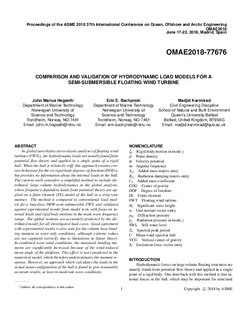Comparison and Validation of Hydrodynamic Load Models for a Semisubmersible Floating Wind Turbine
Chapter
Published version
Permanent lenke
http://hdl.handle.net/11250/2587026Utgivelsesdato
2018Metadata
Vis full innførselSamlinger
- Institutt for marin teknikk [3469]
- Publikasjoner fra CRIStin - NTNU [38525]
Originalversjon
10.1115/OMAE2018-77676Sammendrag
In global aero-hydro-servo-elastic analyses of floating wind turbines (FWTs), the hydrodynamic loads are usually found from potential flow theory and applied in a single point of a rigid hull. When the hull is relatively stiff, this approach ensures correct behaviour for the six rigid body degrees-of-freedom (DOFs), but provides no information about the internal loads in the hull. The current work considers a simplified method to include distributed, large volume hydrodynamics in the global analysis, where frequency-dependent loads from potential theory are applied on a finite element (FE) model of the hull in a strip-wise manner. The method is compared to conventional load models for a braceless 5MW semi-submersible FWT, and validated against experimental results from model tests with focus on internal loads and rigid body motions in the main wave-frequency range. The global motions are accurately predicted by the distributed model for all investigated load cases. Good agreement with experimental results is also seen for the column base bending moment in wave-only conditions, although extreme values are not captured correctly due to limitations in linear theory. In combined wave-wind conditions, the measured bending moments are significantly increased because of the wind-induced mean angle of the platform. This effect is not considered in the numerical model, which therefore underestimates the moment response. However, an approach which calculates the loads in the actual mean configuration of the hull is found to give reasonably accurate results, at least in moderate wave conditions.
